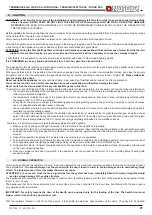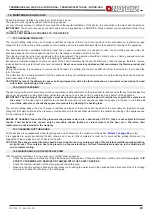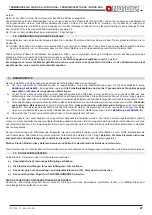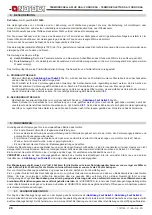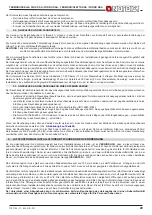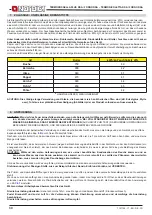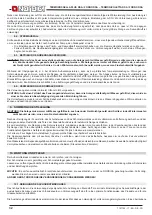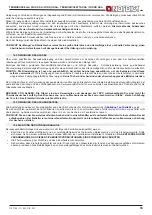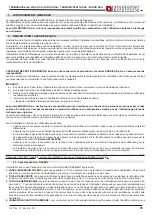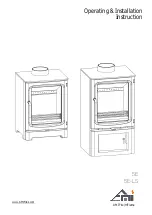
TERMOROSSELLA PLUS DSA / FORNO DSA – TERMONICOLETTA DSA / FORNO DSA
20
important principles must be respected:
• under no circumstances use a flue gas channel with a diameter less than that of the exhaust clamp with which the thermo-product
is equipped;
• each metre of the horizontal stretch of the flue gas channel causes a slight loss of head which must be compensated if necessary
by elevating the flue;
• the horizontal stretch must never exceed 2 metres (UNI 10683-2005);
• each bend of the flue gas channel slightly reduces the flue draught which must be compensated if necessary by elevating it suitably;
• The UNI 10683-2005 – ITALY regulation requires that under no circumstances must there be more than 2 bends or variations in
direction including the intake into the flue.
If the user wishes to use the flue as a fireplace or open hearth, it is necessary to seal the hood below the entrance point of the flue gas
channel pos.
A
.
If the flue is then too big (e.g. 30x40cm or 40x50cm), it is necessary to intubate it with a stainless steel tube with a diameter of at least
200mm, pos.
B
, taking care to close the remaining spaces between the pipe itself and the flue immediately under the chimney pot pos.
C
.
6. AIR FLOW IN THE PLACE OF INSTALLATION DURING COMBUSTION
As the thermo-product draw their combustion air from the place of installation, it is
MANDATORY
that in the place itself, a sufficient quantity
of air is introduced. If windows and doors are airtight (e.g. built according to energy saving criteria), it is possible that the fresh air intake is
no longer guaranteed and this jeopardises the draught of the appliance and your health and safety. It is therefore necessary to guarantee
a supply of fresh air through an external air inlet placed near the appliance or by placing piping for combustion air which leads outside or
to a nearby airy place,
with the exception of the boiler room or garage (FORBIDDEN).
The connection pipe must be smooth with a minimum diameter of 150 mm. It must have a maximum length of 4 m and have no more than
three bends. If it is directly connected to the outside, it must be equipped with a suitable windbreak.
The intake of air for combustion in the place of installation must not be obstructed during operation of the thermo-product. It is absolutely
essential that in environments in which thermo-products are operated with a natural chimney draught, as much air as is necessary for
combustion is introduced, i.e. up to 25 m³/hour. The natural recirculation of air must be guaranteed by some fixed openings to the outside.
Their size is established by regulations regarding the subject. Ask for information from a chimneys weep. The openings must be protected
with grills and must never be blocked up. An extractor hood (suction) installed in the same room or in a neighbouring one causes a
depression in the environment. This causes the leakage of burnt gas (dense smoke, smell); it is therefore necessary to ensure a greater
flow of fresh air.
The depression of an extractor hood can, in the worst case scenario, transform the flue of the thermo-product into an external
air inlet, re sucking the flue gases into the environment with very serious consequences for persons.
7. PERMITTED/FORBIDDEN FUELS
The permitted fuels are wooden logs
. Only dry wooden logs must be used (water content max 20%) .
The wood used as fuel must have a humidity content lower than 20% which is obtained with a drying time of at least one year (soft wood)
or two years (hard wood) placing it in a dry, airy place (for example under roofing). Damp wood makes lighting more difficult, as a greater
quantity of energy is necessary to make the water present evaporate. The humidity content also has the disadvantage, as the temperature
goes down, of causing the water to condense first in the furnace and then in the chimney. Fresh wood contains about 60% H
2
O, therefore
it is not suitable for burning.
Among other things which cannot be burned: carbon residues, cuttings, bark waste and panels, wood which is damp or treated
with varnishes, plastic materials; in this case, the appliance warranty is forfeited
.
Paper and cardboard must only be used for lighting. The combustion of rubbish is forbidden and would also damage the thermo-product
and the flue, causing damage to health and, due to the bad smell, causing complaints from the neighbouring area.
Wood is not a long-lasting fuel and therefore it is not possible to use the thermo-product for continuous heating during the night.
Type
Kg/mc
kWh/kg humidity 20%
Beech
750
4,0
Turkey oak
900
4,2
Elm
640
4,1
Poplar
470
4,1
Larch*
660
4,4
Norway spruc
e
*
450
4,5
Scotch pine*
550
4,4
*
RESINOUS WOOD UNSUITABLE
CAUTION: The continuous and prolonged used of wood which is particularly rich in aromatic oils (e.g. Eucalyptus, Myrtle etc.)
causes the sudden deterioration (flaking) of the cast iron components present in the product.
















